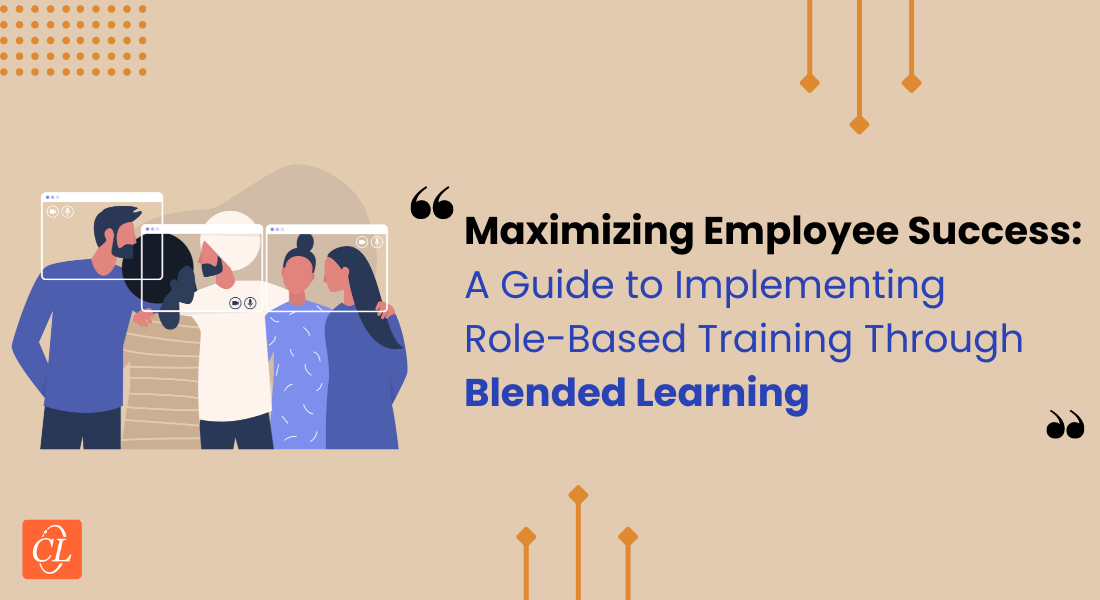How to Use Blended Learning Program for Role-Based Training

Role-based training refers to training programs that are tailored to specific job roles and responsibilities. For example, sales training for sales personnel, customer service training for customer service representatives, and leadership training for managers and executives. Blended learning provides an effective solution for delivering role-based training, as it leverages the strengths of different learning modalities to meet the unique needs and preferences of different types of learners. One of the key benefits of blended learning for role-based training is the flexibility it provides.
In today’s fast-paced work environment, employees often have limited time for formal training programs. Blended learning allows employees to complete some of the training online or at their own pace, while also attending classroom sessions or other interactive training activities. This allows employees to receive the training they need, while also accommodating their busy schedules.
Blended Learning for Role-Based Training is its Ability to Customize Learning Experiences
Top 4 Training Formats for Perfect Blended Learning Programs for Role-Based Training:
- Sales Training
- Customer-Service Training
- Leadership Training
- Technical Training
- Compliance Training
The Role of Blended Learning in Role-Based Training
In addition to flexibility, blended learning also provides greater accessibility to training resources. Online learning platforms can provide access to training materials and resources 24/7, which employees can use to reinforce their learning or revisit key concepts. This allows employees to review the training materials as often as they need to, ensuring they fully understand and retain the information.
Another advantage of blended learning for role-based training is its ability to customize learning experiences. With blended learning, trainers can create targeted training programs that meet the specific needs and learning styles of different types of employees. For example, some employees may prefer self-paced online learning, while others may prefer face-to-face instruction. Blended learning can accommodate both preferences, creating a customized training experience for each employee.
Blended learning can also increase engagement and motivation, as it incorporates a variety of learning activities, including online modules, group discussions, hands-on exercises, and real-life case studies. These engaging activities can help employees stay focused and motivated throughout the training program, which leads to better learning outcomes.
However, blended learning for role-based training also presents certain challenges, such as the need for high-quality online training materials, effective training management systems, and a dedicated support system. For example, online training materials must be well-designed and engaging, with clear and concise instructions, interactive elements, and a good balance of text, images, and videos. A training management system must also be in place to track employee progress, provide feedback, and monitor the completion of training activities. Finally, trainers must be available to provide support and answer questions, ensuring a successful blended learning experience.
Access this free webinar recording to figure out whether your training material is ready for eLearning or not.
Blended learning provides a valuable solution for delivering role-based training in the modern workplace. With its flexibility, accessibility, customization, and engagement, blended learning can help employees acquire the skills and knowledge they need to succeed in their roles. By carefully considering the design, delivery, and management of blended learning programs, organizations can reap the benefits of this innovative approach to training and development.
Role-based training refers to training programs that are specifically designed for specific job roles and responsibilities. Here are some of the common types of role-based training, and how blended learning can be used to create a perfect program for each type:
Top 4 Training Formats for Perfect Blended Learning Programs for Role-Based Training
1. Sales Training
Sales training is a crucial aspect of sales employee development, as it helps them understand the products or services they are selling, as well as develop the skills they need to be successful in their role. A blended learning program for sales training could include online modules covering product knowledge, customer service techniques, and sales techniques, as well as in-person workshops, role-plays, and coaching sessions.
2. Customer Service Training
Customer service training is essential for employees who interact with customers and handle customer inquiries. A blended learning program for customer service training could include online modules covering communication skills, customer service techniques, and problem-solving skills, as well as in-person workshops, role-plays, and coaching sessions.
3. Leadership Training
Leadership training is critical for managers and executives, as it helps them develop the skills they need to lead and manage their teams effectively. A blended learning program for leadership training could include online modules covering leadership theories, communication skills, and team management, as well as in-person workshops, coaching sessions, and mentorship programs.
4. Technical Training
Technical training is important for employees who need to understand and use specific software or technology to perform their job duties. A blended learning program for technical training could include online modules covering software and technology tutorials, hands-on exercises, and simulations, as well as in-person workshops, lab sessions, and coaching sessions.
5. Compliance Training
Compliance training is necessary for employees who need to understand and comply with specific regulations, policies, and procedures. A blended learning program for compliance training could include online modules covering regulatory requirements, policies, and procedures, as well as in-person workshops, group discussions, and coaching sessions.
Different Factors to Consider in Creating an Effective Blended Learning Program
To create a perfect blended learning program for each type of role-based training, it is important to consider the following factors:
1. The Learning Objectives
Determine the specific learning objectives for each type of training and ensure that the blended learning program is designed to meet those objectives.
2. The Learners
Consider the learning styles and preferences of the learners and design the blended learning program to accommodate those preferences.
3. The Delivery Method
Select the most effective delivery method for each type of training, whether it be online modules, in-person workshops, or other learning activities.
4. The Technology
Leverage technology to enhance the learning experience, such as gamification, virtual and augmented reality, and other cutting-edge technologies.
5. The Evaluation
Establish a process for evaluating the effect of the blended learning program and make necessary adjustments to ensure the program is effective.
By considering these factors, organizations can create a blended learning program that is effective, engaging and meets the unique needs of each type of role-based training.
Why is Blended Learning an Effective Approach for Role-Based Training?
Blended learning can be a highly effective approach to role-based training for several reasons:
Flexibility
Blended learning offers learners the flexibility to learn at their own pace and on their own time, which is especially beneficial for employees who have busy schedules. This also allows learners to repeat certain modules or activities as needed to ensure they have a solid understanding of the material.
Personalized Learning
Blended learning allows organizations to tailor the learning experience to the specific needs of each role, which helps to ensure that the training is relevant and impactful. This can be done by using online modules to provide general information, and in-person workshops or coaching sessions to focus on specific skills or practices.
Engagement
Blended learning provides opportunities for learners to be actively engaged in the learning process, which can help to increase motivation and engagement. For example, role-plays, simulations, and hands-on activities can be used to help learners apply what they have learned to real-world scenarios.
Increased Retention
Blended learning allows learners to engage with the material in different ways, which can help to increase retention. For example, by reviewing online modules and participating in in-person workshops, learners can reinforce what they have learned and retain the information better.
Improved Assessment
Blended learning provides opportunities for organizations to assess the effectiveness of their training programs and adjust as needed. For example, online modules can be designed to include quizzes or eLearning assessments, and in-person workshops can be designed to include activities or role-plays that allow learners to demonstrate their knowledge and skills.
To Conclude
In conclusion, blended learning is an efficient approach to role-based training because it provides a flexible, personalized, engaging, and impactful learning experience for employees. By leveraging the strengths of both online and in-person learning, organizations can create training programs that meet the specific needs of each role and help employees develop the skills they need to be successful in their jobs.





